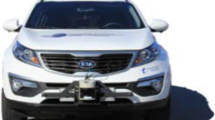Abstract
Driving a trailer is not difficult when driving forward; however, it is challenging when driving in reverse because the trailer turns opposite to the steering direction of the vehicle and the parking characteristics vary depending on the trailer length. The shorter the trailer is, the higher is the steering response sensitivity; this results in reverse parking complexities. Therefore, this paper proposes an improved method to reverse-drive a trailer into a parking space autonomously. Specifically, an optimal steering angle is obtained for auto-parking trailers of all sizes. The trailer is autonomously parked using a simple pure pursuit tracking algorithm without establishing an infrastructure. Therefore, the proposed method enables the trailer to detect the parking location and auto-park without any input from the driver.
Similar content being viewed by others
References
T. Sigfried, “Pro tip for backing up a trailer,” Outdoorsy, https://www.outdoorsy.com/blog/pro-tips-for-backing-up-a-trailer, August 2020.
C. Chen, B. Wu, L. Xuan, J. Chen, T. Wang, and L. Qian, “A trajectory planning method for autonomous valet parking via solving an optimal control problem,” Sensors, vol. 20, no. 22, November 2020.
Z. Leng and M. Minor, “A simple tractor-trailer backing control law for path following,” Proc of IEEE/RSJ International Conference on Intelligent Robots and Systems, pp. 5538–5542, October 2010.
J. Cheng, B. Wang, Y. Zhang, and Z. Wang, “Backward orientation tracking control of mobile robot with N trailers,” International Journal of Control, Automation, and Systems, vol. 15, pp. 867–874, March 2017.
M. Yue, X. Wu, L. Guo, and J. Gao, “Quintic polynomial-based obstacle avoidance trajectory planning and tracking control framework for tractor-trailer system,” International Journal of Control, Automation, and Systems, vol. 17, pp. 2634–2646, July 2019.
J. Hansen, Rydeshopper Magazine, June 2020.
C. Pradalier and K. Usher, “A simple and efficient control scheme to reverse a tractor-trailer system on a trajectory,” Proc. of IEEE International Conference on Robotics and Automation, pp. 2208–2214, May 2007.
E. Bejar and M. Antonio, “Backing up control of a self-driving truck-trailer vehicle with deep reinforcement learning and fuzzy logic,” Proc. of IEEE International Symposium on Signal Processing and Information Technology (ISSPIT), pp. 202–207, December 2018.
M. Hejase, J. Jing, J. M. Maroli, Y. B. Salamah, L. Fiorentini, and Ü. Özgüner, “Constrained backward path tracking control using a plug-in jackknife prevention system for autonomous tractor-trailers,” Proc. of 21st International Conference on Intelligent Transportation Systems (ITSC), pp. 2012–2017, November 2018.
C. Pradalier and K. Usher, “Experiments in autonomous reversing of a tractor-trailer system,” Proc. of 6th International Conference on Field and Service Robotics — FSR, July 2007.
H. S. Shin, M. J. Kim, and J. H. Kim, “Path generation and tracking algorithm of auto valet parking system development,” Transactions of KSAE, vol. 28, no. 6, pp. 389–399, June 2020.
Z. Zhang, W. Cheng, and Y. Wu, “Trajectory tracking control design for nonholonomic systems with full-state constraints,” International Journal of Control, Automation, and System, vol. 19, pp. 1798–1806, February 2021.
J. M. Snider, Automatic Steering Methods for Autonomous-Automobile Path Tracking, Master’s Thesis, Robotics Institute Carnegie Mellon University, Pennsylvania, USA, 2009.
A. Elhanssan, Autonomous Driving System for Reversing an Articulated Vehicle, Master’s Thesis, School of Electrical Engineering Department of Automatic Control, second level Stockholm, Sweden, 2015.
J. Liu, X. Zhao, H. Guo, and H. Chen, “Tractor semitrailer modeling and regional path tracking control strategy,” Proc. of Chinese Automation Congress (CAC), pp. 1961–1966, November 2020.
A. C. Manav and I. Lazoglu, “A novel cascade path planning algorithm for autonomous truck-trailer parking,” IEEE Transactions on Intelligent Transportation Systems, vol. 23, no. 7, pp. 6821–6835, 2022.
T. Kabbani, C. A. Lúa, and S. di Gennaro, “Vehicle reference generator for collision-free paths,” International Journal of Control, Automation, and Systems, vol. 17, pp. 181–192, January 2019.
C. A. Lúa, G. De Jesus Díaz, S. Di Gennaro, and T. Kabbani, “Vehicle reference generator for collision-free trajectories in hazardous maneuvers,” Mathematical Problems in Engineering, pp. 1–10, January 2018.
Author information
Authors and Affiliations
Corresponding author
Additional information
This work was supported by BK21 Program (5199990814084) through the National Research Foundation of Korea (NRF) funded by the Ministry Education.
Heeseok Shin received his B.S. degree in physics from Suwon University in 2016. He is currently pursuing a Ph.D. degree in Kookmin University. His research interests are autonomous vehicles, vehicle control, path generation, auto-parking system, and trailer auto valet parking system.
Myeong-Jun Kim received his B.S. degree in information and telecom. engineering from Incheon National University in 2017, an M.S. degree in Automotive Engineering from Kookmin University in 2019, and is currently a Ph.D. student in the same graduate school. His research interests include autonomous vehicles, perception system, object detection, and sensor fusion.
Sunwoo Baek received his B.S. degree in control and instrumentation engineering from Korea University in 2017. He is currently a Ph.D. student in Kookmin University. His research interests are vehicle control, deep learning, vision systems, motion planning, and unmanned vehicles.
Carl D. Crane received his B.S. and M.S. degrees from the Department of Mechanical Engineering, the Rensselaer Polytechnic Institute in 1978, and a Ph.D. degree from the University of Florida in 1987. He is currently a professor in the Department of Mechanical and Aerospace Engineering, University of Florida.
Jungha Kim received his B.S. degree from the Department of Mechanical Engineering, Sungkunkwan University, in 1981, an M.S. degree from the Department of Mechanical and Aerospace Engineering, University of Cincinnati, in 1985, and a Ph.D. degree from the Department of Mechanical Engineering and Applied Mechanics, University of Pennsylvania, in 1990. He is currently a professor in the Department of Automotive Engineering, Kookmin University.
Publisher’s Note
Springer Nature remains neutral with regard to jurisdictional claims in published maps and institutional affiliations.
Rights and permissions
About this article
Cite this article
Shin, H., Kim, MJ., Baek, S. et al. Perpendicular Parking Path Generation and Optimal Path Tracking Algorithm for Auto-parking of Trailers. Int. J. Control Autom. Syst. 20, 3006–3018 (2022). https://doi.org/10.1007/s12555-021-0268-9
Received:
Revised:
Accepted:
Published:
Issue Date:
DOI: https://doi.org/10.1007/s12555-021-0268-9




